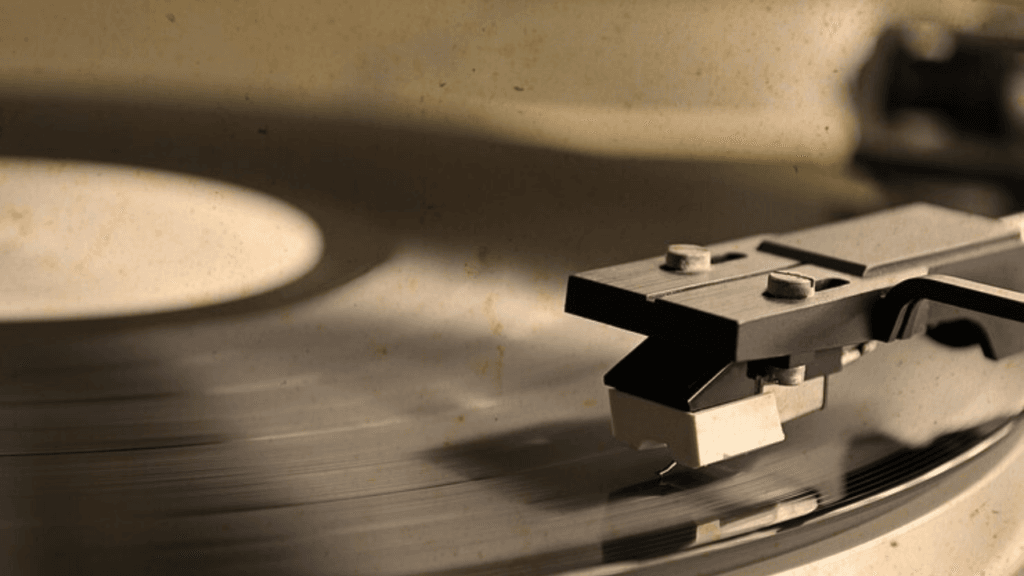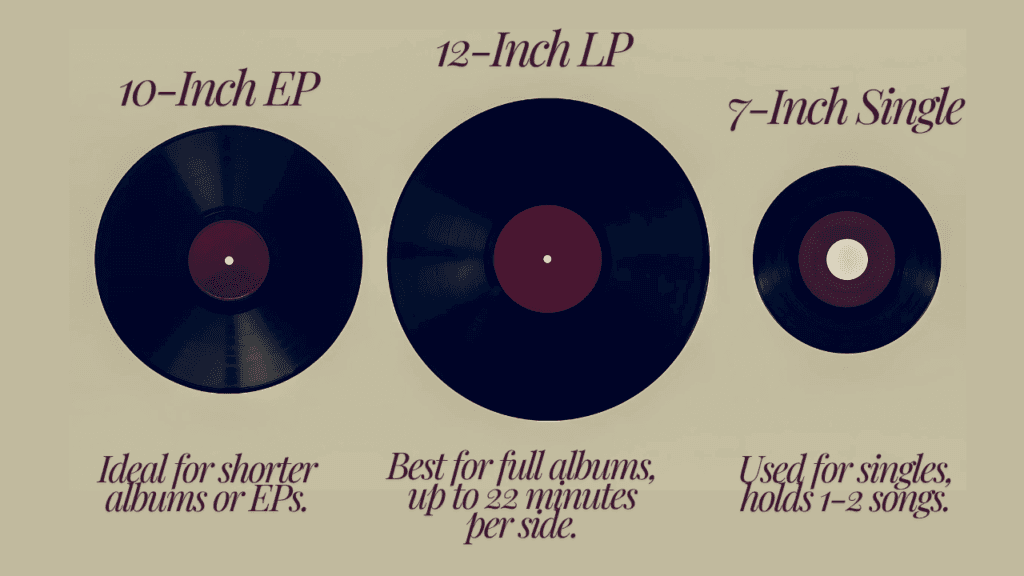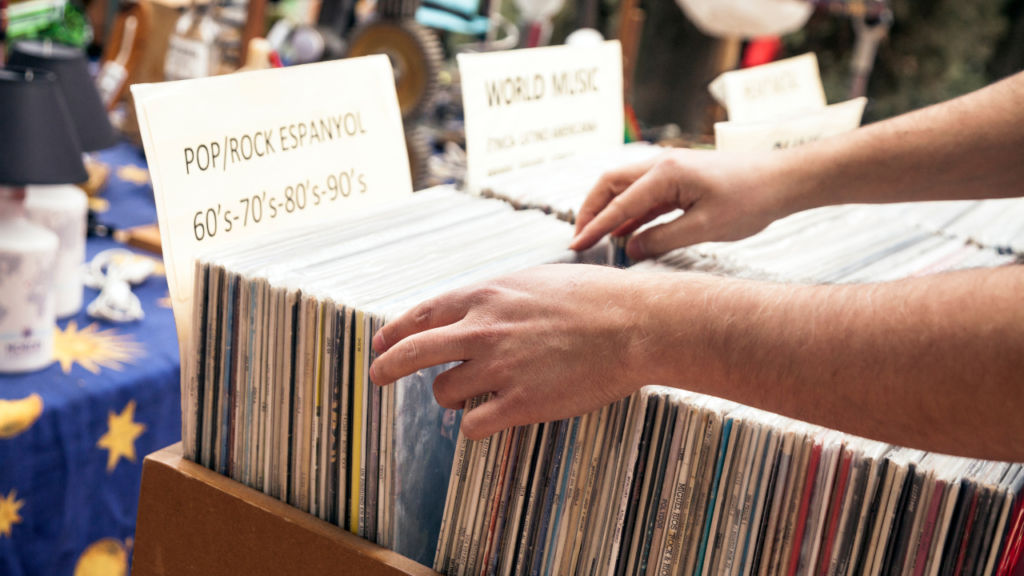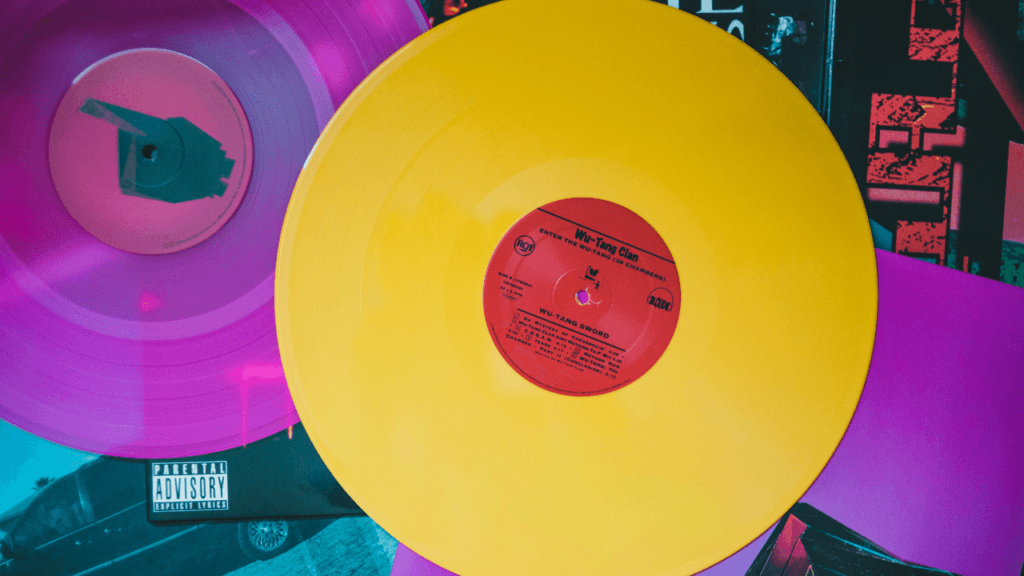In a world dominated by digital music streaming, vinyl has made a surprising comeback. For many, vinyl records symbolize authenticity, offering a tangible connection to music that MP3s or streaming can’t provide. This resurgence, often called the “vinyl revival”, has seen vinyl outsell CDs for the first time since the 1980s. As a result, many music enthusiasts are looking to start or expand their vinyl collection. In this guide, we’ll cover everything from choosing records to looking after them, giving both beginners and enthusiasts a well-rounded view of vinyl collecting.

Before You Start Collecting
Before diving into the world of vinyl collecting, it’s essential to define your goals and understand what drives your passion for vinyl.
Define Your Vinyl Collection Goals
Understanding why you’re collecting vinyl is the first step. For audiophiles, vinyl offers a warm analog, deeper bass, and overall superior sound compared to compressed digital formats. The analog nature of vinyl captures the music nuances, providing a richer listening experience. For others, vinyl records represent a sense of nostalgia, taking them back to the album era with physical artwork and liner notes.
For example, someone looking to curate a unique vinyl collection with rare pressings will have different priorities than someone building a collection based on sound quality. If you’re an audiophile, you might focus on high-fidelity pressings and audiophile-grade records. If you’re driven by nostalgia, you might look for records that remind you of your youth or significant moments in your life.
Pro Tip: Focus your collection on a niche to avoid becoming overwhelmed. Start with a specific genre like classic rock, 1980s punk or a single artist’s discography. This will help you build a cohesive collection that reflects your musical tastes.
Choosing Genres or Artists
Some genres, like jazz and rock, are well-suited to building a vinyl collection, due to their original analog production techniques. Jazz fans should look for original Blue Note pressings, known for their exceptional sound quality and historical significance. Classic rock collectors should aim for first pressings of albums by The Beatles, Led Zeppelin or Pink Floyd, as these often have superior sound quality and higher collectible value.
In contrast, Pop or electronic music might be cheaper and more accessible in digital form. But there are exceptions, like Daft Punk’s “Random Access Memories”, which was meticulously produced for vinyl and offers a superior listening experience.
Pro Tip: Start with artists you know you love before branching out into more experimental purchases.
Understanding Different Vinyl Formats
Vinyl comes in various formats, each with its unique characteristics. Here’s a breakdown of the most common formats:
- 7” Singles: Typically hold one track on each side, often used for promotional singles. These are usually cheaper but may require more frequent flipping.
- 12” LPs (Long Play): Standard albums, often with better sound quality due to the wider grooves. They’re more immersive for full album listening sessions.
- EPs (Extended Play): A middle ground between singles and albums, typically containing 3-5 tracks.

Pro Tip: If you plan on building a comprehensive vinyl collection with full albums, stick with 12” LPs. If you’re looking to collect rare, early singles, the 7” format is a must-have for your collection.
Budgeting for Your Vinyl Collection
Setting Realistic Expectations
Forbeginners, it’s important to understand that building a vinyl collection can be an expensive hobby. First-time collectors can expect to spend $20-$30 per new record. Limited editions or rare finds, however, can cost hundreds or even thousands of dollars. For instance, an original pressing of The Beatles’ “White Album” can cost hundreds of dollars, depending on condition.
Pro Tip: Set a monthly budget and use apps to track your purchases so you don’t go overboard.
Where to Buy on a Budget
You don’t have to break the bank to build a vinyl collection. Here are some budget-friendly options:
- Record Stores: Many have a bargain bin section, where you can find hidden treasures. Local stores also tend to offer loyalty programs.
- Garage Sales/Flea Markets: These can be hit-or-miss but sometimes yield incredible finds at a fraction of the cost.
- Online: Sites like eBay allow for careful comparison shopping.

Example: It’s not uncommon to find valuable albums like “Rumours” by Fleetwood Mac for under $5 at a flea market .
Other Hidden Costs
While building a vinyl collection can be expensive, there are other costs to consider:
- Turntable & Audio Equipment: Expect to spend between $100-$500 for a good beginner turntable.
- Record Sleeves: Invest in anti-static sleeves to keep your collection in pristin condition.
- Storage Solutions: Shelving units and crates will add to the cost, but are necessary to keep your records organized and safe.
Pro Tip: Look for budget options like IKEA Kallax shelving for vinyl storage.
Equipment Essentials for Vinyl Collectors
To get the most out of your vinyl collection, you’ll need the right equipment. Here are the essentials to get you started:
Choosing the Right Turntable
When it comes to turntables, you have two main options: belt-drive and direct-drive. Belt-driven turntables offer quieter performance and are preferred for casual listening, while direct-drive systems, found in DJ setups, provide quicker start-up times and higher torque.
Pro Tip: If you’re new to vinyl, start with a reliable belt-driven turntable like the Audio-Technica AT-LP60, known for its affordability and solid performance.
Key Accessories
In addition to a turntable, there are several key accessories you’ll need to get the most out of your vinyl collection.
- Phono Preamp: Necessary if your turntable doesn’t come with one built-in, as it amplifies the weak signal from the record.
- Carbon Fiber Brushes: Helps remove dust and prevent scratches.
- Record Sleeves: Anti-static sleeves protect your records from dust and static buildup.
- Cleaning Kits: Investing in a stylus cleaning kit is essential to maintain sound quality over time.
Pro Tip: Use a stylus cleaner like LAST Stylus Cleaner to extend the life of your needle.
Building Your Vinyl Collection
How to Choose Your First Records
Starting your vinyl collection can be both exciting and overwhelming. With so many options, where do you begin? Let’s break it down.
Start with the Classics
When building your first vinyl collection, it’s a good idea to begin with some universally celebrated albums. These records not only offer great music but also serve as a solid foundation for your collection. For classic rock enthusiasts, albums like Abbey Road by The Beatles, Dark Side of the Moon by Pink Floyd, and Led Zeppelin IV are must-haves. These records are iconic and often feature groundbreaking production techniques that sound fantastic on vinyl.
Jazz lovers should consider Kind of Blue by Miles Davis, A Love Supreme by John Coltrane, and Blue Train by Lee Morgan. These albums are not only seminal works in the jazz genre but also showcase the warm, rich sound that vinyl is known for.
Other essential records to consider include Rumours by Fleetwood Mac, The Velvet Underground & Nico, and Nevermind by Nirvana. These albums span different genres and eras, offering a well-rounded start to your collection.
Understanding Vinyl Condition
The condition of a vinyl record dramatically affects its value and sound quality. Here’s a breakdown of grading terms to help you understand what you’re buying:
- Mint (M): Flawless, never played. Rare for older records.
- Near Mint (NM): Almost perfect but may have been played once or twice.
- Very Good Plus (VG+): Light scratches but plays without skipping.
- Very Good (VG): More noticeable wear, but still playable.
Pro Tip: For beginners, VG or VG+ is usually a great balance between quality and affordability. You get good sound without paying a premium for near-mint condition.
Original Pressings vs. Reissues
When it comes to building a vinyl collection, you’ll often hear about original pressings and reissues. Original pressings are the first editions of records and are often more sought after by collectors due to their rarity. They may feature different artwork or sound mixes compared to later reissues.
Reissues, on the other hand, are often cheaper and pressed using modern equipment. They can offer superior sound due to remastering techniques. If you’re more interested in sound quality, modern reissues often provide a better experience for less money.

Pro Tip: If you’re just starting out, focus on reissues to build your collection without spending a fortune. You can always hunt for original pressings later as you become more experienced.
Best Places to Buy Vinyl Records
Local Record Stores

Shopping locally offers a tactile experience that online buying cannot. You can physically inspect the records, talk to knowledgeable staff, and even listen to some albums before making a purchase. Some stores specialize in specific genres, making it easier to find what you’re looking for.
Pro Tip: Become a regular at your local store. Many will let you know when new stock comes in or even hold rare records for you.
Online Marketplaces
- Discogs: The go-to platform for collectors to buy, sell, and research vinyl. Discogs allows users to track their collection and wishlist, providing a global marketplace for rare finds.
- eBay: A good platform for bidding on rare records, though grading standards may vary.
- Amazon: Primarily for new releases, though some sellers offer used records.
Pro Tip: Always check seller ratings and ask for detailed pictures before buying online to avoid damaged goods.
Vinyl Record Fairs and Conventions
Record fairs are a treasure trove for collectors, offering a chance to dig through crates and discover rare pressings. Many cities hold annual or semi-annual events where vendors from all over come to sell their records.
Record Store Day, a global event held every April, offers limited-edition releases and is a must-attend for any serious collector.
Pro Tip: Arrive early to vinyl fairs for the best finds, and bring cash to negotiate deals with vendors.
How to Grade and Sell Vinyl Records
Why Accurate Grading Matters
Properly grading your vinyl is essential for buying, selling, and maintaining your vinyl collection. Accurate grading ensures buyers know what they’re getting and helps you fairly price your records when it’s time to sell.
Pro Tip: Use natural light or a bright lamp to inspect the vinyl surface for scratches and imperfections. Listen to the record before selling to catch any audio issues such as skips or pops.
If you plan to sell a record like Pink Floyd’s Dark Side of the Moon, for example, condition plays a huge role in its value. A first pressing in Near Mint (NM) condition can fetch several hundred dollars, while a Good (G) copy may only sell for $50.
Where to Sell Vinyl Records
Once you’ve graded your vinyl, there are several ways to sell them and make room for new additions to your vinyl collection.
- Online Marketplaces: Discogs and eBay are popular platforms where sellers can list vinyl and reach a global audience. Both platforms provide pricing guidelines based on past sales, helping sellers set a fair price.
- Local Record Stores and Fairs: Visiting local record shops or attending vinyl fairs offers an opportunity to sell your records directly to collectors or store owners. Some stores buy collections, while others allow consignments where they take a cut of each sale.
- Social Media Groups: Facebook and Instagram vinyl communities have become a hot spot for direct buying and selling. These communities are often niche-focused, making it easier to find the right audience for rare or collectible records.
Pro Tip: If you’re selling in person, bringing documentation about the pressing (year, label, any special notes) can help you justify your pricing.
Maintaining Your Vinyl Collection
Why Maintenance Matters
Maintaining your vinyl collection is crucial for ensuring its longevity and preserving sound quality. Without proper care, your records can warp, get dusty or deteriorate over time which diminishes both their value and your listening experience. Imagine finding that rare first pressing of Abbey Road only to discover it’s unplayable due to neglect. Ouch!
Proper maintenance is more than just keeping your records clean. It’s about creating an environment where they can live. This means storing them upright, in a cool dry place, away from direct sunlight and extreme temperatures. Vinyl is sensitive, and even small environmental changes can affect its condition.

Storing and Cleaning
While we’ve touched on some basics, there’s much more to keeping your collection pristine. From storing records in the right conditions to regular cleaning techniques that prevent surface noise and wear, proper maintenance is an art in itself. For example, anti-static sleeves can prevent dust buildup, and a carbon fiber brush can remove surface particles before each play.
For more detailed instructions, check out our in-depth articles. Explore our Guide to Storing Vinyl Records to learn how to keep your collection in top condition, and dive into the Guide to Cleaning Vinyl Records for expert cleaning tips that will maintain the sound quality of your vinyl.
Final Thoughts
Starting with a clear goal helps you focus your efforts, whether you’re an audiophile seeking superior sound quality or a nostalgic collector hunting for rare pressings to add to your vinyl collection. Budgeting ensures you can enjoy your hobby without financial strain, and proper maintenance guarantees your collection’s longevity.

Remember, vinyl collecting is a journey. It’s about finding new music, appreciating the artistry of album covers and enjoying the warm sound of vinyl. So take your time, explore different genres and most importantly, have fun.
So, what are you waiting for? Dive in and let the music play!


